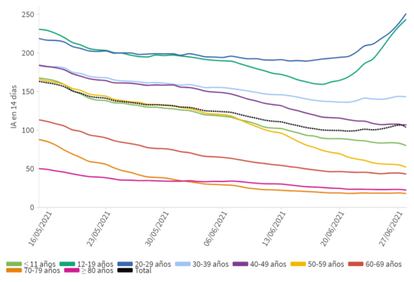Coronavirus incidence rate among young Spaniards rises to twice the national average
Since June 22, around 600 people under the age of 30 have been admitted into intensive care with Covid-19 and 80 have died


The coronavirus pandemic is now hitting young people in Spain. With most over-60s vaccinated with at least one dose of a Covid-19 vaccine and the immunization of the 40-50 age group speeding up, the virus is spreading primarily among young people who have not been vaccinated.
The incidence rate for the under-40s, in particular the 12-19 and 20-29 age brackets, has risen dramatically. It is these infections that have reversed the downward trend of the epidemiological curve in Spain. According to the latest Health Ministry report, released Tuesday evening, the 14-day cumulative number of cases per 100,000 inhabitants now stands at 107, up from 100 on Monday. This data point has been on an upward trend for the last week. But the incidence rate is even higher among the 20-29 age group, standing at 251 cases – more than double the national average.
The mass outbreak linked to students returning from vacation in Mallorca, which has led to more than 1,000 infections, is just the tip of the iceberg. Fernando Simón, the director of the Health Ministry’s Coordination Center for Health Alerts (CCAES), said on Monday that the outbreak represents just “2.5% of cases in the last 14 days and 5% of cases in the last seven days.” There are many other outbreaks, although on a smaller scale.
According to experts, the easing of coronavirus restrictions, combined with the end-of-term student trips and the fact that young people are typically more mobile and socially active, mean the virus is spreading via social contact. “Contagions of the variants [such as the delta, which is 60% more transmissible according to the European Center of Disease Control and Prevention] is on the rise,” explained Alberto Infante, professor of international health at the Carlos III Health Institute. “What’s more, the restrictions on movement and nighttime venues have been lifted and young people have finished their studies and are eager to get out.”
The Health Ministry report released on Tuesday recorded 7,000 new infections and added 40 deaths to the official toll, which now stands at 80,829. For the first time, the report also included a breakdown of the incidence rate by age group. These figures highlight the impact of the Covid-19 vaccination drive. According to the report, 25 million people have received at least one dose of a Covid-19 vaccine, while 17 million (36%) are fully vaccinated. For over-70s, who are almost all fully vaccinated, the 14-day cumulative number of cases per 100,000 inhabitants is between 17 and 22. For the 60-70 age group, who have nearly all received one dose of the vaccine, while 55% are still waiting for the second shot, the incidence rate is around 52. And for the 40-49 demographic, 85% of whom have received their first dose, it is 103, but on a downward trend. The Health Ministry report on Tuesday did not record the daily changes in the incidence rate by age group, but did publish the following graph, which shows the spike in contagions in the 12-19 and 20-29 age groups from May 16 (represented by the dark green and dark blue line, respectively).

With respect to the 30-39 age group, who are beginning to receive vaccination appointments, the 14-day cumulative number of cases has also risen slightly since May 15, and now appears to have plateaued at around 143 cases. This data point jumps to 251 and 243 cases for the 20-29 and 12-29 age groups, respectively. Case rates in the under-11s have, however, seen a slow drop, coming now at below 80 cases per 100,000.
Experts say that this uptick in contagions in Spain is not likely to lead to hospitals and intensive care units (ICUs) becoming overwhelmed, as happened in previous waves of the pandemic. In general, the coronavirus cases among youngsters are minor or even asymptomatic. But experts warn that young people should not lower their guard as some cases may lead to hospitalization.
According to the most recent report from the Carlos III Health Institute, since June 22, 2020, when the deescalation of coronavirus restrictions came to an end, around 600 people under the age of 30 have been admitted to intensive care units (ICUs) and 80 have died. An 18-year-old in Elche who contracted the coronavirus after traveling to Mallorca for student holidays was recently admitted into the ICU.
Differences between the regions
Contagion levels in the 12-19 age bracket are on the rise in Asturias, Balearic Islands, the Canary Islands, Valencia, Extremadura, Castilla y León, Galicia, Murcia and Catalonia. In Barcelona, the number of cases recorded among young people has risen fourfold since the end of the state of alarm on May 9.
In Madrid, where the incidence rate has risen the most, the 14-day cumulative number of cases per 100,000 inhabitants among adolescents is close to 300. Meanwhile, in La Rioja, the incidence rate for the 12-19 age group has fallen, but in the 20-29 population, it is over 500 cases. And in Cantabria, which has the highest incidence rate in Spain, with 180 cases, this data point jumps to over 600 in the 20-29 age bracket.
English version by Melissa Kitson.
Tu suscripción se está usando en otro dispositivo
¿Quieres añadir otro usuario a tu suscripción?
Si continúas leyendo en este dispositivo, no se podrá leer en el otro.
FlechaTu suscripción se está usando en otro dispositivo y solo puedes acceder a EL PAÍS desde un dispositivo a la vez.
Si quieres compartir tu cuenta, cambia tu suscripción a la modalidad Premium, así podrás añadir otro usuario. Cada uno accederá con su propia cuenta de email, lo que os permitirá personalizar vuestra experiencia en EL PAÍS.
¿Tienes una suscripción de empresa? Accede aquí para contratar más cuentas.
En el caso de no saber quién está usando tu cuenta, te recomendamos cambiar tu contraseña aquí.
Si decides continuar compartiendo tu cuenta, este mensaje se mostrará en tu dispositivo y en el de la otra persona que está usando tu cuenta de forma indefinida, afectando a tu experiencia de lectura. Puedes consultar aquí los términos y condiciones de la suscripción digital.
More information
Últimas noticias
Maduro pleads not guilty before the federal court in New York: ‘I am still the president of Venezuela’
A new test can detect Alzheimer’s from a finger prick
UN team enters Sudanese city of El Fasher after paramilitary massacre: ‘It’s like a ghost town’
A recipe for resistance: Indigenous peoples politicize their struggles from the kitchen
Most viewed
- Gilles Lipovetsky: ‘If you want to live better and fall in love, take Prozac, don’t look to philosophy’
- Alain Aspect, Nobel laureate in physics: ‘Einstein was so smart that he would have had to recognize quantum entanglement’
- Alvin Hellerstein, a 92-year-old judge appointed by Bill Clinton, to preside over Maduro’s trial in New York
- Why oil has been at the center of Venezuela-US conflicts for decades
- Maduro’s downfall puts China’s relationship with Venezuela to the test










































